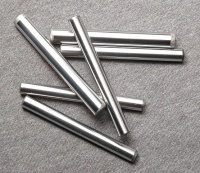Same relative deflections across scales

Deflections induced by accelerations from mechanical motions are scale invariant
This is one important reason for why macroscale style machinery at the nanoscale works better rather than worse at the nanoscale.
See main article: How macroscale style machinery at the nanoscale outperforms its native scale
Contents
[hide]Relevance for scale transposed prototyping
Scale invariance of deflections from machine motions is a very important result for applicability of macro 3D printing for nanomachine prototyping.
This is because it means that 3D printed macroscale prototypes will typically vastly underperform nanoscale target systems of equal geometry.
(Slight under-performance is desirable from a exploratory engineering perspective)
From the stiffness aspect, there is no risk to accidentally prototype a macroscale system that then cannot be ported to the nanoscale.
Heck, if anything this may lead to uncircumventable massive over-engineering in macroscale prototypes.
Over-engineering that ...
- will surely work at the nanoscale, but
- will also be be very far from optimal.
See: How macroscale style machinery at the nanoscale outperforms its native scale
Same absolute speed across scales
A necessary assumption to get
same relative deflections across scales (aka scale invariance of relative deflections)
is to have same absolute speed across scales (aka scale invariance of absolute speeds).
This is why keeping speeds constant across scales can be seen as a natural choice.
v∝L0⇔ϵ∝L0
When more or less deviating from that natural choice then relative
deflections scale the same as the speeds are scaled. That is:
When slowing down across scales then one (unsurprisingly) reaps the benefit of smaller relative deflections.
Some such deviation seems well motivated by dynamic friction in gem-gum technology being reducable by
deliberate slowdown at the lowest assembly level & increasing bearing area to decrease friction.
But this happens in a rather nonlinear fashion across scales. Not like a scaling law.
An issue here is the still unclear mesoscale friction gap.
Still, when trying to approximate deliberate slowdown at the lowest assembly level with a scaling law
then it might be roughly a square-root law or weaker:
v∝L1/2⇔ϵ∝L1/2
Scaling speeds linear with L would be way too much
as it would fully counter higher throughput of smaller machinery
In all further analysis scale invariance of speeds and deflections is assumed.
Analyzing scaling behavior of relative deflections
Without loss of generality only the one dimensional case of tensile strain is covered.
Scaling of deformations from machine motions (spoiler: they are scale invariant)
Accelerations from machine motions go up too worsening the situation.
One millionth the size => One million times the accelerations.
But don't fret just yet. We have a quite literally massive compensating factor.
With scaling down machinery to smaller sizes the mass of that machinery is going down.
One millionth the size => (One millionth)³ the mass.
The critical quantity we want to be preserved across scales is relative strain:
ϵ=Δl/l
Strain epsilon is proportional to stress sigma.
ϵ=σ/E
Stress is given by applied force F.
σ=F/A
A natural level of force for a scale is centrifugal force from rotating a mass at that scale.
F=mω2r=m(2πf)2r
Putting it all together we get:
ϵ=σ/E=F/(EA)=mω2r/(EA)
With known scaling laws for the base quantities as such:
- mass m: L3
- frequency f (and angular velocity ω): L−1
(Note that this only holds when absolute speed v is kept scale invariant) - radius r: L1
- tensile elastic modulus E: L0
- area A: L2
We get:
F=m⏟+3ω2⏟−2r⏟+1∝L2
ϵ=m⏟+3ω2⏟−2r⏟+1/(E⏟0A⏟+2)∝L0=const
In words:
- Force F scales with L2
- Both stress & strain from machine motions scale with L0
In other words when assuming scale invariant speed then:
Both stress & strain (relative deflections) from machine motions are scale invariant.
Alternative path:
From: Lower stiffness of smaller machinery
We know the that the scaling law for spring constants is:
k∝L1
And substituting for E in former result we get the same final result via different path:
E=k (l/A)
ϵ=σ/E=m⏟+3ω2⏟−2r⏟+1/(k⏟+1l⏟+1)∝L0=const
Scaling of deformations from gravity
Fgrav=ρVg∝L3
ϵgrav=σgrav/E=Fgrav/(EA)=ρVg/(EA)∝L1
Both stress & strain from gravity go down linearly with smaller scales.
(wiki-TODO: Self-gravity of mega-structures should scale differently. Maybe look into that too. But that goes into wild SciFi territory.)
Scaling of deformations from thermal motions
A natural place to start out seems to be setting the deformation energy equal to the thermal emergy:
Etherm=Eel
Assigning a block no matter the size just gets one degree of freedom for one thermal energy package (equipartitioning theorem),
and ignoring small constant pre-factors we get:
Etherm=kBT
Eel=kelx/2
Definition of relative deflections is:
ϵtherm=x/l
Putting all so far together:
kBT=kellϵtherm/2
And (with l∝L¹) we finally get:
2kBT/(kell)=ϵtherm∝L−1
That's for the average tensile deflections from just kT worth of flexing energy.
Obviously a crystolecule rod (e.g. Kaehler brackets)
have more internal degrees of freedom (phonon modes) than one
but these shouldn't contribute much.
Especially for free standing small crystolecules allowing only for high energy modes.
(TODO: May be bogus. Investigate that.)
Note that the scale of thermal motion induced deflections at the atomic scale is already at the atomic scale.
And it only gets smaller from there upwards the scales.
There at the atomic scale deflections are big enough though to be of concern for piezomechanosynthesis
and unguided covalent welding.
For details see: Lattice scaled stiffness & Stiffness.
Related
- How macroscale style machinery at the nanoscale outperforms its native scale
- Misleading aspects in animations of diamondoid molecular machine elements and
A better intuition for diamondoid nanomachinery than jelly
Gem-gum - Applicability of macro 3D printing for nanomachine prototyping
- Lower stiffness of smaller machinery, Stiffness, The feel of atoms
- Scaling law
- Deliberate slowdown at the lowest assembly level
- Increasing bearing area to decrease friction
- Optimal sublayernumber for minimal friction
- Another very important as of 2022 barely known scaling law:
Higher throughput of smaller machinery - Stiffness